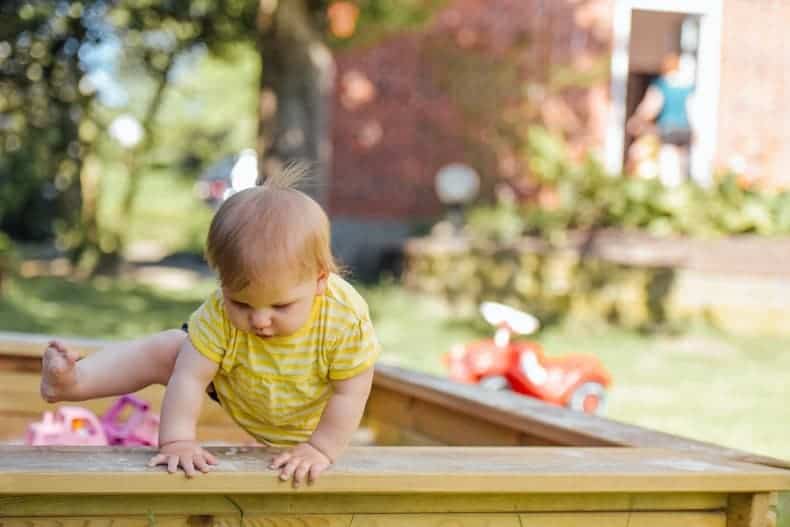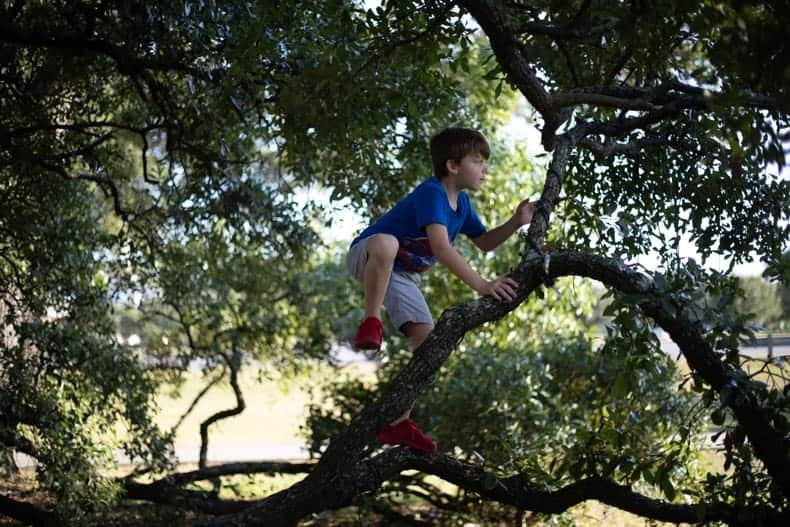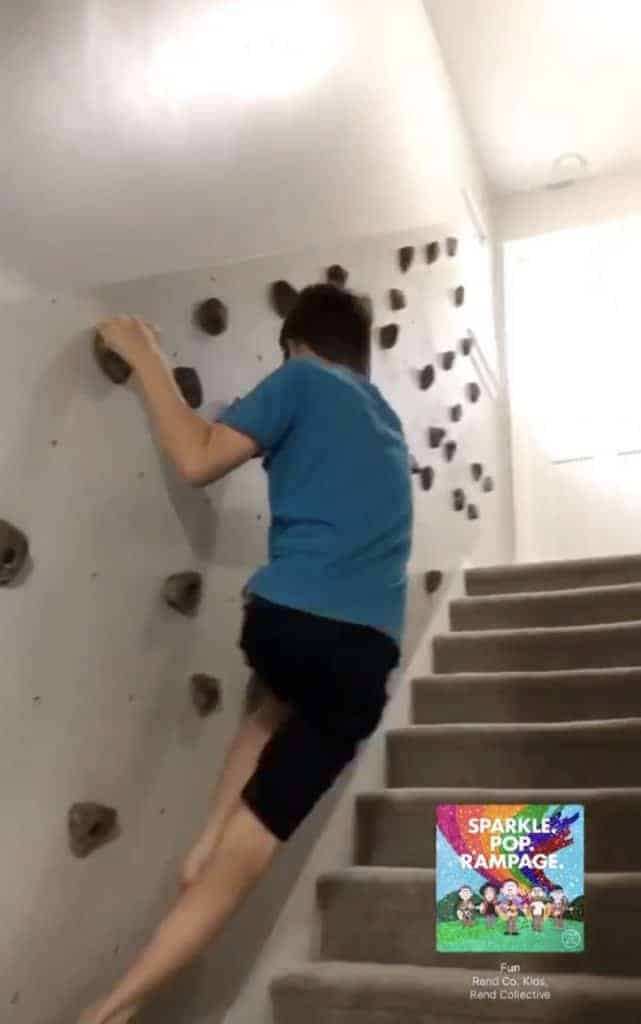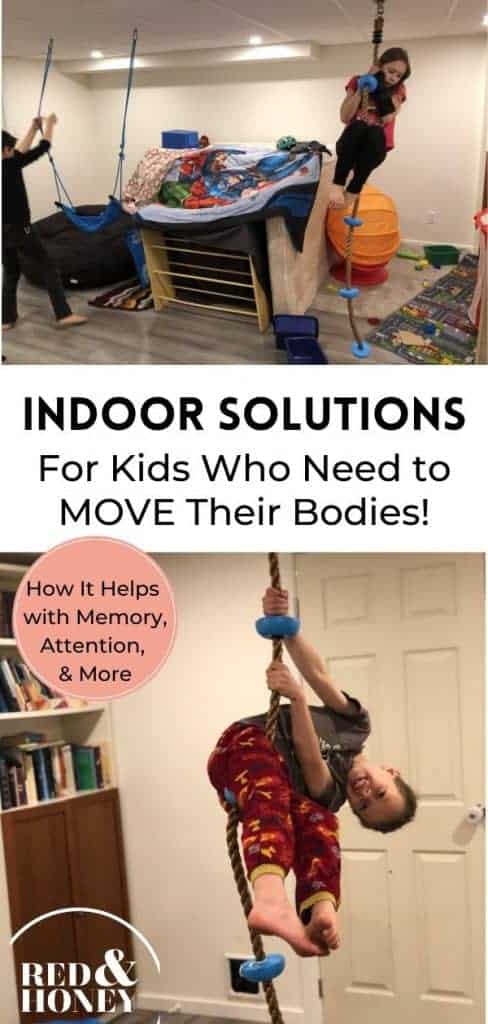Indoor gross motor activities are a great way to get kids moving, improve coordination, and boost overall health. They are also a great outlet for kids who struggle with attention and sensory issues. Instead of relying on screen time, try setting up some of these ideas for the next time you’re stuck inside.

I don’t know about your kids, but my four little darlings are the wiggly type. (Do non-wiggly kids exist? I have zero experience in that department, so I can’t say.)
We live in a 4-season Canadian climate where winter is pretty darn… wintery. We essentially live in a snow globe between November and March. While winter has its perks, and we’ve learned to embrace it (tobogganing, backyard skating rinks, and epic snow forts), there are definitely times where the weather forces us inside.
From what I hear, those living in more southern climates have the opposite problem, and actually see the summer months as a time to hibernate inside because the heat is so oppressive! And then of course, there are primarily rainy climates, too. No climate has perfect weather all the time.
Regardless of where you live, there are going to be days where the kids are stuck inside and they wind up driving you bonkers with their massive amounts of energy, bouncing off walls. (Where do they get it all?! Oh yeah, they siphon it from us, the parents. Ha!)
They aren’t doing anything wrong (despite our teeth-clenching nerves telling us otherwise), but it does basically take the patience of a saint to watch them bounce off the walls and not do anything about it. In fact – kids NEED to move in big ways in order to develop their bodies and brains properly!
So. The way I see it is we had two choices:
1) Get mad when they try to express that big energy and make them sit down and be quiet, and when that doesn’t work – numb them with screen time, or…
2) Come up with a workable solution in the house that meets their very real, legit needs for indoor gross motor activities on a daily basis.
We chose option #2. (And I’m so glad we did!!)
What Are (Indoor) Gross Motor Skills?
This complicated sounding term basically just means being able to move and control our body. Gross motor skills involve the large muscles, like arms, legs, and the core. Fine motor skills are necessary for tasks that use small muscles, like holding a pencil or picking a flower.
What Do Gross Motor Activities Teach Kids?
Kids need to be comfortable moving their own bodies, but gross motor activities provide even more benefits.
Gross motor skills help:
- Build confidence and self-esteem.
- Develop the ability to assess risk. When to go for it and when to hold back.
- Provide physical, social, and emotional energy release.
- Lay the foundational groundwork for brain development and learning.
- So much more!
What Affects Gross Motor Development?
It Starts Before We’re Born
Researchers have looked at factors that affect gross motor development as far back as the birth canal. Moms with diabetes or gestational diabetes are more likely to have children with delayed gross motor skills. The higher mom’s blood sugar is during or before pregnancy, the worse their children’s attention spans and motor functions were (source).
Note: If this was a factor for you, though, don’t despair. The exciting and relatively new field of brain plasticity actually tells us that our brains can change and develop new skills later in life too!
Vitamin D
How much sunlight kids get also has an impact on their gross motor skills. Children with low vitamin D levels are more likely to have gross motor development delays, like learning how to walk later than their peers.
On the upside, infants in this study saw significant improvement in gross motor skills after Vitamin D supplementation.
In our family, we supplement with Vitamin D during the winter months.

Get Up and Move!
Kids who are overweight or underweight are also more likely to have problems with their gross motor development. Both conditions make it harder for kids to control their muscles (source, source).
By far though, not moving around enough has the biggest impact on gross motor development. In other words – the more you do it, the easier and more effective it is. That’s why we need indoor gross motor activities!
There’s a direct relationship between how much TV and sitting time kids have and their gross motor skills (source).
Researchers in this study found a direct link between little to no physical activity and gross motor development. The more time spent sedentary, like sitting at a desk, or only doing light physical activity (like walking around), the worse gross motor skills are.
Kids need more intense physical activities, like running, jumping, climbing, spinning, rolling, climbing, and more. You know – all of those classic kid movements that adults forgot how to do!
Stretching and other movement activities that help kids control large muscle groups also play an important role in development. This study discovered the more flexible kids were, the better their motor skills.
The earlier we address the problem, the better. In this study, kids who did P.E. at school improved their gross motor skills. However, the younger kids saw more gains than the older age groups.
Most kids don’t get enough active time, but boys seem to be especially hard hit in this area. Boys have a higher risk than girls of having delayed motor development.
Kids with underdeveloped gross motor skills are more likely to develop diabetes and heart disease later in life. It’s estimated that 47 million Americans already deal with these health problems.
Gross Motor Skills for Young Brains
During my kids’ few years in public school, one of the things that I saw that made me sad was when a kid would be made to stay inside for recess as a consequence for poor behaviour in the classroom. How backwards! Kids actually behave better when they are given plenty of time to run and play.
Active playtime develops the muscles kids need for things like coordination and balance, but it also flexes their brains. In this study, kids with more advanced gross motor skills showed better brain development.

Too many teachers and parents worry children will get behind academically and up the time spent sitting at a desk. Instead of making a 5 year old sit and “read” for an hour, letting them run, jump, and play will have a much more profound effect on their academics.
Physical activity improves brain function, grows nerve cells, and forges brain connections. The benefits of these childhood activities even carry over into adulthood, keeping our brains sharp as we get older. The more physical activity children have, the better their learning and memory are.
As a homeschool family, I delight in sending my kids outside to run and play, and counting it as “school”. I definitely approach my kids education eclectically, and feel that running barefoot and free outside is valuable (but also – making them finish their math first). And now – our indoor gross motor activities options means we enjoy this benefit year-round!
Improving Academics
Physical movement improves test scores in several areas and reduces time spent mentally wandering off task by over 20%. Children with good gross motor skills have better accuracy and reading comprehension. They complete tasks faster and are more likely to read above their grade level (source).
This study found that lagging gross motor skills were linked with learning disabilities and delayed reading and math skills. There was a direct correlation between the two. The poorer the kid’s motor skills, the more behind they were academically. Children who struggled with object control skills (like throwing and catching a ball), struggled more with math.
Physical activity is also known to improve language learning, attention span, and memory (source).
If it seems to you like there’s an influx of these sorts of issues among children in our society – you’d be correct. Much of this is attributed to the changes in how kids play these days. More physical activity and free gross motor movement-type play would definitely help this situation. (We’ve observed this impact in our own family, in fact.)
Beyond the Five Senses: Propioception & More
Did you know that getting enough outdoor or indoor gross motor activity helps kids way more than just wearing them out for a good night’s sleep? (Though that’s a perk for us tired parents, amiright?!) It’s true!
We all learned about the five senses when we were kids, but there are actually a few more forgotten senses that are super important.
We also have proprioceptive sense (the ability to know where our limbs and body parts are without seeing them), vestibular sense (the ability to sense balance and position in relation to the earth), and interoceptive sense (sensing what’s going on inside your body – like hunger, etc.)
These senses are all super important in the big picture of a child’s development. For example: one of our kids has ADHD tendencies. One of his biggest struggles is impulse control. When I was doing endless amounts of reading on how to approach this holistically, I found a lot of literature talking about the link between these struggles and underdeveloped proprioception or vestibular senses. It makes perfect sense: if his brain has trouble keeping track of his limbs, or sensing his body’s position in relation to other things, it’s really no wonder he’s often squeezing way too tight on a hug, hitting or kicking playfully but actually hurting, or just generally crashing through the house like a locomotive.
(Examples like that are exactly what led us to searching for indoor gross motor solutions at home.)
The more they move their bodies, the more children intuitively develop their proprioception and vestibular senses.
Our muscles, joints, and skin contain sensory receptors that give our body feedback and tell us how to move.
For example: try climbing with and without shoes on. When bare feet are allowed to get sensory input from a surface our toes, ankles, knees, hips, and every muscle and joint in the body know how to engage to prevent injury. Putting shoes over these natural sensory receptors muffles the message our feet send to the brain.
Read: 5 Reasons To Let Your Children Go Barefoot
Tying it into the Vestibular System
The vestibular system is closely related to proprioception. Together the two help us be aware of our bodies, maintain balance, and stabilize and improve posture. The vestibular system is a tiny little organ inside our inner ear that helps with balance and spatial awareness.
Ever spun around really fast and got dizzy? Done a headstand? Swung high on the playground? These are ways the body develops the vestibular system. Exercising this way is an important part of helping children develop their brains and bodies.
It’s especially helpful for kids with sensory disorders and attention problems like ADHD or sensory processing disorder.
The Big Question: How Can Kids Practice Gross Motor Skills Indoors?
Let any kid loose in a varied and inviting outdoor setting with plenty of trees to climb, hills to roll down, and a creek to splash in for good measure – and it’s problem solved, right? That’s childhood in a nutshell, in an ideal world. But what about when real life hits and the weather is truly miserable? Or you don’t have a huge yard, and need to maximize both inside and outside play spaces? Or you just don’t have three hours every day to take the kids to the park? (Hello, reality.)
Here’s what we did: Indoor Gross Motor Activities
When we bought our house in 2019 it had an unfinished basement. We planned to renovate it right away to add bedrooms, and we also included a large play room area where we could add some gear.
This was the wishlist I came up with:
- Swing
- Climbing Rope
- Cargo net on the wall, or suspended
- Monkey bars
- Rock climbing wall
- Spinning chair
- Pogo sticks and scooters
- Mini trampoline
- Balance beam
- Balance board
So far we’ve installed a swing and climbing rope in the basement play room (we purposefully chose a drop ceiling during our reno to make it easier to install stuff like this, but it can be done with a regular ceiling if you have someone skilled to install for you), plus we have already had a mini trampoline and a spinning chair from IKEA.

We threw in a couple of spent mattresses that we’d replaced (one day I’d like to buy proper gym mats, but this will do for now), and the kids have used their incredible creativity to play for hours in that space. They’ve created obstacle courses for each other to jump, roll, and tumble through. They’ve used the swing as monkey bars (why not?!), and they’ve spent plenty of time just doing what kids are supposed to do – be wild.
I think our next addition will be a swinging gym bar with mats underneath, or maybe a killer climbing wall like my friend Steph from Cheapskate Cook. She recently shared about hers in her Instagram story, and I’m super inspired! Go watch that here.
Here’s a screenshot I grabbed from her story. Awesome, right?

While we have a great space in our basement dedicated to rough-and-tumble play, I know that not everyone has a whole room they can dedicate to this. There are still lots of ways you can incorporate the general ideas though – and there’s something for every size of space. Indoor gross motor activities can be as simple or as complicated as you want – kids just need opportunity and permission. 😉
- Stephanie’s climbing wall is along a staircase – no extra space required!
- I’ve seen lots of examples of swings being installed on the main floor in a hallway. I’d totally do that if we didn’t have one in the basement.
Here’s the swing we have:

- Emphasize the smaller equipment instead of the bigger stuff: mini trampolines can fit almost anywhere, like a bedroom, or the corner of a living room.
- A climbing rope just needs a few square feet – the action is all vertical!
Here’s the one we have:

- Another small item with big impact is a balance board. There are cute instagrammable wooden versions for kids, like this. (But there are also the adult versions that are marketed as a fitness accessory. Both would work!)

Note: to install the swing and climbing rope, my husband ordered and used this hardware, as well as this set.
Bottom line? Let Your Kids MOVE Their Bodies!
If reality dictates that frolicking in nature for hours each day of the year isn’t always feasible (true for most of us) then be sure to consider how you can get a little creative and adopt some solutions that work for your family.
It’s vital to their health and development for kids to engage in a variety of gross motor activities on a daily basis. Their bodies and brains need this kind of movement in order to develop optimally, and they’ll be happier for it!
Do you have any creative indoor gross-motor activities solutions for your kids in your home?


Leave a Comment